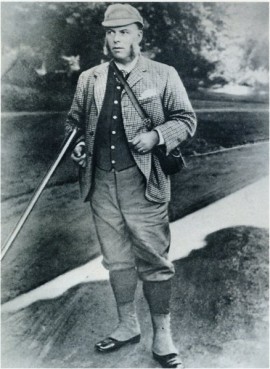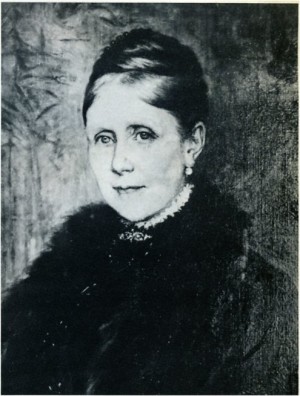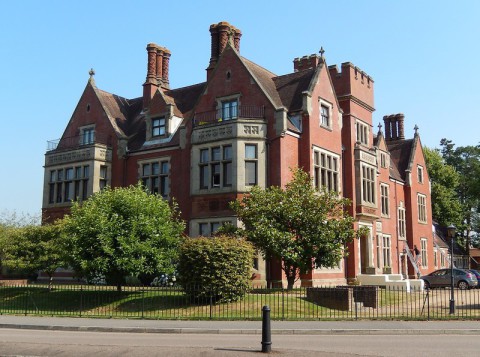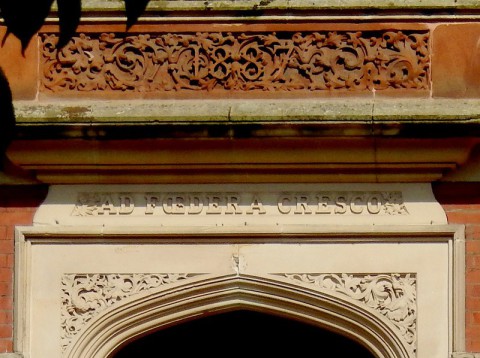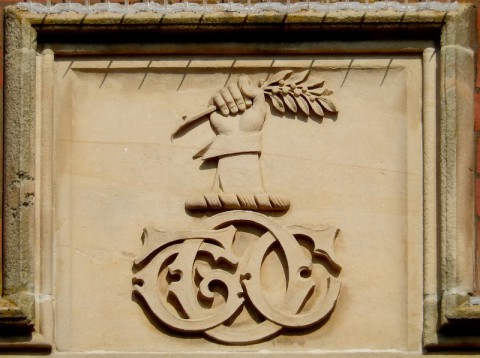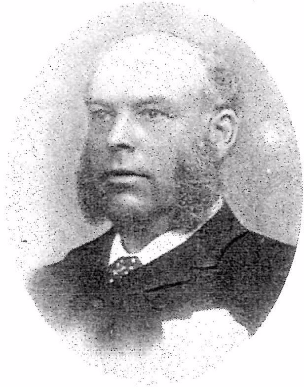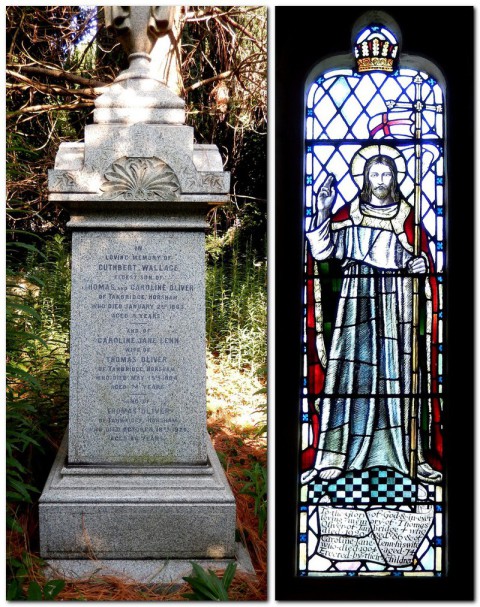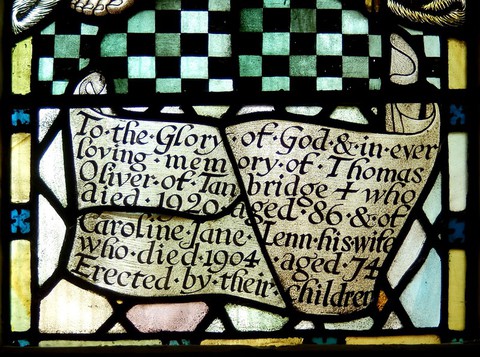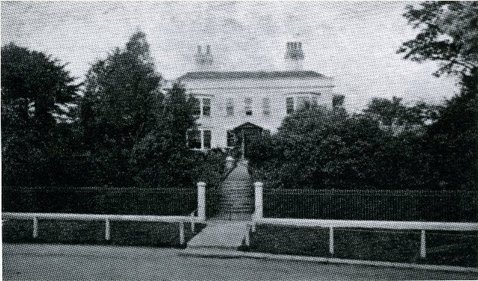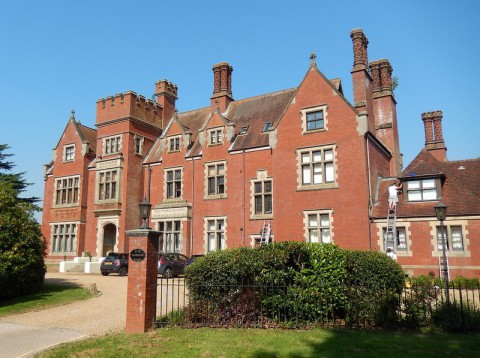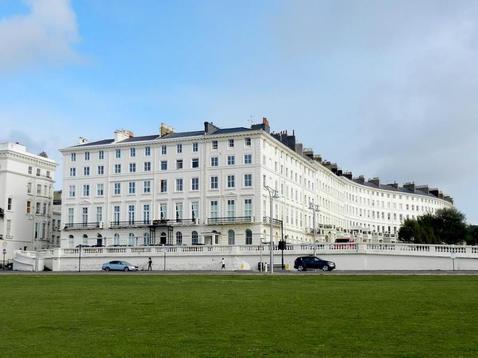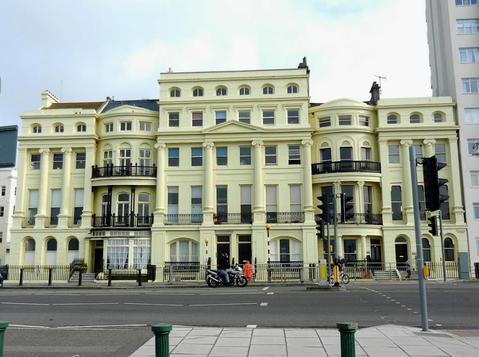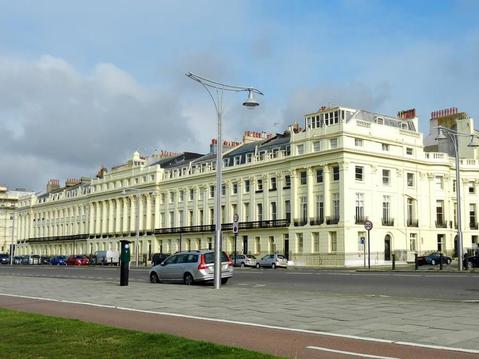Thomas Oliver - Tunnel Builder
Thomas Oliver was one of the two contractors who built the Dore & Chinley Railway, the other being J.B. Edwards of Chester. It was Thomas who built the first ten and a half miles of track between Dore & Totley and Hope stations, including the whole of the Totley tunnel.
Thomas Oliver was born in 1834 in Lowton, near Newton le Willows in Lancashire, the fifth son and seventh child of Cuthbert Oliver, a railway contractor from Allendale, Northumberland and his wife Ann (nee Crow).
By the time of the 1841 Census, the family had moved to Hasland, Chesterfield, and Thomas's parents were to remain there for the rest of their lives, becoming quite wealthy land and property owners. Like his father and his older brother Edward, Thomas established himself as an engineer and contractor, specialising in large civil engineering projects, especially those connected with the emerging railway network.
Thomas served his apprenticeship under Charles Bartholomew in Doncaster. Bartholomew was the engineer in charge of improving the navigation of the River Don and also the engineer to South Yorkshire, Doncaster and Goole Railway. In January 1854, at the age of 19, Thomas Oliver married Caroline Jane Lenn Gichard in York. She was four years older than Thomas, the youngest of six children born to William Michael Gichard, a Cornish gentleman of independent means, and his wife Elizabeth. Their first child, Cuthbert Wallace Oliver was born towards the end of the same year in Masborough, Rotherham.
Shortly after, Thomas was engaged to work for two and a half years to John Towlerton Leather on the improvement of the River Nene Navigation between Wisbech, Cambridgeshire and Peterborough, Northamptonshire. Mr Leather was later to become infamous when, as the Consulting Engineer for the Sheffield Water Works Company, he prepared the plans and specifications for the Dale Dyke Reservoir which broke its embankment on the night of 11th/12th March 1864 causing the great "Sheffield Flood" with the loss of around 240 lives.
A second child, Thomas William Nene Oliver, was born in Wisbech in the first quarter of 1856. The following year Thomas began working for Edward Woods as the Resident Engineer in charge of the work to build the tracks in Sussex around Petworth, Midhurst and Horsham; the Shrewsbury to Welshpool line; and the Horsham to Guildford line. The Olivers had moved to Horsham in 1857 and were living at West Parade at the time of the 1861 Census. Thomas must have become quite successful because also living with him were a nephew, niece and sister-in-law, supported by a governess and two general servants. His elder son, Cuthbert, died in 1863 at age 8, but two more children were to be born soon after, Caroline Ann in 1863 and Frederick Lenn in 1866.
Edward Woods proposed Thomas's application to become an Associate of the Institution of Civil Engineers, in 1865, after which Thomas began working on his own account as a railway contractor. He was awarded a contract from the London, Brighton and South Coast Railway to add a second line between Coulsdon and Earlswood.
Thomas Oliver won a contract valued at almost £150,000 to build a railway from Mansfield to Worksop and work began in June 1870. In the same year he bought Tanbridge House, off Worthing Road, in Horsham and was living there at the time of the 1871 Census when, aged 37, his occupation was recorded as "railway contractor employing about 950 men". Later the same year, another daughter Mary Helen was born. In 1875 Thomas secured a lucrative contract to build the Bennerley and Bulwell railway in Nottinghamshire, including the boring of the 151 yard Watnall tunnel. Also in 1875 work began on the Swadlincote loop in Derbyshire including two tunnels at Midway (104 yards) and Woodville (307 yards). In 1878 Thomas Oliver contracted to build and manage the line from Chichester to Midhurst.
In the 1881 Census Thomas's occupation is shown as "civil engineer and railway contractor employing 918 men" plus a "farmer employing 6 men, 2 boys and 2 women." Tanbridge House was a substantial property, but the Olivers had it demolished and rebuilt on an even grander scale in 1887.
Above the door is a Latin inscription which reads "AD FOEDERA CRESCO", meaning "I gain by treaty" or "I grow for treaties". On the front of the building is the Oliver crest of a fist clenching an olive branch, together with the entwined initials T, C & O representing Thomas and his wife Caroline Oliver. To service the new building, the Olivers were employing seven servants by 1891.
From 1888 to 1894, there are numerous references in the Sheffield and north Derbyshire newspapers to Thomas Oliver during the building of the 6,230 yard Totley Tunnel. Some are in relation to the outbreak of smallpox amongst the navvies, their safety and welfare, and also to damage and obstruction to roads. But not all reports were bad. In a detailed and highly factual report on progress, the Sheffield Independent of 8 June 1889 reported that Totley Grove Hall was unoccupied and being "done up" and that Thomas Oliver intended to reside there; meantime his son, T. W. N. Oliver was representing him on the spot. The article went on to praise Thomas for his efforts to minimise the impact of the influx of over 600 navvies and their families on the local area:
The full article, and more than a dozen others, on the construction of the eastern section of the Dore and Chinley Line, are to be found in our Newspaper Archive and make fascinating reading. They give detailed accounts of the enormous difficulties that were presented to the contractor and overcome by the skill and determination of the engineers, first amongst whom was Percy Rickard.
The tunnel opened for goods traffic on 6 November 1893 and for passenger traffic on 16 May 1894 and the project was deemed to be an enormous success. The Midland Railway made what has been described as an outstandingly generous settlement to Thomas Oliver & Sons, who even received an extra £14,500 unsolicited award in recognition of unprofitable work on a quarter of the length of the tunnel.
Soon after the Totley Tunnel was completed, Thomas Oliver & Sons won a contract for building a 15 mile section of the new London to Sheffield line which was to include a 2,997 yard tunnel at Catesby in Northamptonshire. The first shaft was sunk on 18 Feb 1895 and the tunnel was completed by 27 May 1897, progress being greatly enhanced by the use of "steam navvies", which Thomas had previously used successfully at Totley and in the construction of a reservoir and filtering beds at Barrow Gurney near Bristol.
Although they retained Tanbridge House, Thomas and Caroline spent their later years living in Hove, Sussex. Caroline died of cancer in 1904 but Thomas outlived his oldest remaining son. He died on the 8 October 1920 at Abington in Lanarkshire aged 86. He is buried in Denne Road graveyard in Horsham where there is a family stone.
His children paid for a window in the Chapel of the Holy Trinity at the nearby Parish Church of St Mary. The single lancet window is of a bearded figure of Christ made up of stained and painted glass. Installed in 1924, it was designed by Frederick Etchells who noted that "the glass is designed with a minimum of colour in order not to obscure the light in the chapel".
Also near Worthing Road is Oliver Road, named in his memory.
Photos of the Olivers, and the Horsham part of this history: Hidden Horsham
Thomas Oliver in Public Records
Births, Marriage's and Deaths
| Name | Event | Place | Registration Date | Age |
|
Caroline Jane Lenn Gichard (wife) |
Birth |
Little Colan, St Columb, Cornwall |
abt. 1830 | |
| Thomas Oliver | Birth |
Lowton, Newton le Willows, Lancashire |
22 Mar 1834 | |
| Thomas Oliver | Baptism |
Winwick, Lancashire |
29 Apr 1834 | |
| Thomas Oliver and Caroline Jane Lenn Gichard | Marriage |
York, Yorkshire |
27 Jan 1854 | |
|
Cuthbert Wallace Oliver (son) |
Birth |
Masboro, Rotherham, Yorkshire |
Oct-Dec 1854 | |
|
Thomas William Nene Oliver (son) |
Birth |
Wisbech, Cambridgeshire |
Jan-Mar 1856 | |
|
Francis Gibbon Oliver (son) |
Birth |
Horsham, Sussex |
Jul-Sep 1861 | |
|
Cuthbert Wallace Oliver (son) |
Death |
Horsham, Sussex |
2 Jan 1863 |
8 |
|
Caroline Ann Oliver (daug.) |
Birth |
Horsham, Sussex |
Jul-Sep 1863 | |
|
Frederick Lenn Oliver (son) |
Birth |
Horsham, Sussex |
Jul-Sep 1866 | |
|
Mary Helen Oliver (daug.) |
Birth |
Horsham, Sussex |
Oct-Dec 1871 | |
|
Caroline Jane Lenn Oliver (wife) |
Death |
Horsham, Sussex |
15 May 1904 | 74 |
| Thomas William Nene Oliver (son) | Death |
Steyning, Sussex |
Oct-Dec 1915 | 61 |
| Thomas Oliver | Death |
Gilberscleugh, Abingdon, Lanarkshire |
8 Oct 1920 | 86 |
| Thomas Oliver | Burial |
Denne Road graveyard, Horsham, Sussex |
13 Oct 1920 | |
|
Francis Gibbon Oliver (son) |
Death |
Elham, Kent |
Jul-Sep 1927 | 66 |
|
Caroline Ann Tonge, nee Oliver (daug.) |
Death |
Tonbridge, Kent |
Oct-Dec 1939 | 77 |
|
Frederick Lenn Oliver (son) |
Death |
Newton Abbot, Devon |
Jan-Mar 1942 | 75 |
|
Mary Helen Savill, nee Oliver (daug.) |
Death |
Uckfield, Sussex |
Jul-Sep 1963 | 91 |
1841 Census, Stony Bridge, Hasland, Chesterfield, Derbyshire
| Name | Age/Born | Occupation | Born in County |
|
Cuthbert Oliver |
53 c. 1788 |
railway contractor |
No |
|
Edward Oliver |
15 c. 1826 |
railway contractor |
No |
|
John Oliver |
12 c. 1829 |
|
No |
|
Mary Oliver |
9 c. 1832 |
|
No |
| Thomas Oliver |
7 c. 1834 |
|
No |
|
Phoebe Oliver |
4 c. 1837 |
|
No |
| Mary Cook |
32 c. 1809 |
female servant |
No |
1851 Census, White Bank House, Hasland, Chesterfield, Derbyshire
| Name | Relation | Condition | Age/Born | Occupation | Birthplace |
|
Cuthbert Oliver |
Head
|
Married
|
63 c. 1788 |
proprietors of houses and land |
Northumberland, Allendale |
|
Ann Oliver |
Wife
|
Married
|
56 c. 1795 |
Durham, Hamsterley |
|
|
Thomas Oliver |
Son |
Unmarried |
17 c. 1834 |
engineer |
Lancashire, Lowton |
|
Mary Ann Oliver |
Daug. |
Unmarried |
19 c. 1832 |
|
Lancashire, Lowton |
| Elizabeth Rigby | Visitor |
Married |
36 c. 1815 |
|
Durham, Witton |
|
William Rigby |
Visitor |
Married |
40 c. 1811 |
railway contractor |
Lancashire, Lowton |
| Ann Redfearn | Servant |
Unmarried |
25 c. 1850 |
house servant |
Derbyshire, Alderwasley |
|
Sarah Hardy |
Servant | Unmarried |
19 c. 1832 |
house servant |
Derbyshire, Findern |
.
1861 Census, West Parade, Horsham, Sussex
| Name | Relation | Condition | Age/Born | Occupation | Birthplace |
|
Thomas Olliver |
Head
|
Married
|
27 c. 1834 |
civil engineer |
Lancashire, Lowton near Newton le Willows |
|
Caroline Jane Lenn Oliver |
Wife
|
Married
|
31 c. 1830 |
Cornwall, Little Colan near St. Columb |
|
|
Cuthbert Wallace Oliver |
Son |
|
6 c. 1855 |
scholar
|
Yorkshire, Masbro' |
| Thos. Wm. Nene Oliver | Son |
|
5 c. 1856 |
scholar |
Cambs., Wisbech |
|
Maria Merrifield |
Sister in law |
Married |
49 c. 1812 |
cook |
Cornwall, ?, St Austell |
| Ann Merrifield | Niece |
Unmarried |
9 c. 1852 |
|
Cornwall, ?, St Austell |
| Matthew Oliver | Nephew |
Unmarried |
17 c. 1944 |
pupil |
Yorshire, Masbro' |
| Marian Birch | Governess |
Unmarried |
24 c. 1837 |
governess |
Shropshire, Shrewsbury |
| Marian Napper | Servant |
Unmarried |
20 c. 1841 |
general servant |
Sussex, Horsham |
|
Elizabeth Balchin |
Servant |
Unmarried |
18 c. 1843 |
general servant |
Sussex Loxwood |
1861 Census, White Bank House, Hasland, Chesterfield, Derbyshire
| Name | Relation | Condition | Age/Born | Occupation | Birthplace |
|
Cuthbert Oliver |
Head
|
Married
|
73 c. 1788 |
railway contractor retired |
Northumberland, Allendale |
|
Ann Oliver |
Wife
|
Married
|
66 c. 1795 |
Durham, Linesack |
|
|
Mary Ann Oliver |
Daug. |
Unmarried |
29 c. 1832 |
|
Lancashire, Lowton |
| Elizabeth Page | Visitor |
Married |
22 c. 1839 |
|
Surrey, Croydon |
|
Mary Minn |
Servant |
Married |
26 c. 1835 |
cook |
Derbyshire, Stainsby |
| Elizabeth Minn | Servant |
Unmarried |
21 c. 1840 |
general servant |
Derbyshire, Stainsby |
1871 Census, Tanbridge House, Worthing Road, Horsham, Sussex
| Name | Relation | Condition | Age/Born | Occupation | Birthplace |
|
Thomas Oliver
|
Head
|
Married
|
37 c. 1834
|
railway contractor employing about 950 men |
Lancashire, Newton le Willows |
|
Caroline Oliver |
Wife
|
Married
|
40 c. 1831 |
Cornwall, St. Columb |
|
|
Caroline Annie Oliver |
Daug.
|
|
8 c. 1863
|
|
Sussex, Horsham |
|
Frank Lenn Oliver |
Son
|
|
4 c. 1867 |
|
Sussex, Horsham |
| Charlotte Rhodes | Servant |
Unmarried |
27 c. 1844 |
|
Sussex, Shipley |
|
Matlilda Jenkins |
Servant |
Unmarried |
24 c. 1847 |
|
Sussex, Rusper |
| Emily Berned? | Servant |
Unmarried |
21 c. 1850 |
|
Sussex, Horsham |
|
Joseph Besam? |
Servant | Unmarried |
22 c. 1849 |
groom |
Yorkshire, Wentworth |
1881 Census, Tanbridge, Worthing Road, Horsham, Sussex
| Name | Relation | Condition | Age/Born | Occupation | Birthplace |
|
Thomas Oliver
|
Head
|
Married
|
47 c. 1834
|
civil engineer & railway contractor employing 918 men; farmer employing 6 men, 2 boys and 2 women |
Lancashire, Lowton
|
|
Caroline Jane Lenn Oliver |
Wife
|
Married
|
49 c. 1832 |
Cornwall, St. Columb |
|
|
Thomas William Nene Oliver |
Son
|
Unmarried
|
25 c. 1856
|
civil engineer
|
Cambs., Wisbech |
|
Frank Gibbon Oliver |
Son
|
Unmarried
|
19 c. 1862 |
brewer's pupil
|
Sussex, Horsham |
| Caroline Annie Oliver |
Daug.
|
Unmarried
|
17 c. 1864 |
Sussex, Horsham |
|
|
Mary Helen Oliver |
Daug.
|
Unmarried
|
9 c. 1872 |
Sussex, Horsham |
|
| Edward Lawrence |
Unmarried |
22 c. 1859 |
gardener |
Sussex, Shipley |
|
|
Lucy Pullen |
Unmarried |
28 c. 1853 |
domestic servant |
Sussex, Petworth | |
| Fanny Lovekins |
Unmarried |
20 c. 1861 |
domestic servant |
Sussex, Horsham | |
|
Sarah Mills |
Unmarried |
19 c. 1862 |
domestic servant |
Sussex, Slinfold |
|
| Kate Voller |
Unmarried |
16 c. 1865 |
domestic servant |
Sussex, Plaistow |
1891 Census, Tanbridge, Worthing Road, Horsham, Sussex
| Name | Relation | Condition | Age/Born | Occupation | Birthplace |
|
Thomas Oliver |
Head | Married |
57 c. 1834 |
civil engineer & contractor for public works |
Lancashire, Lowton |
|
Caroline J. Oliver |
Wife
|
Married |
61 c. 1830 |
Cornwall, Little Colan |
|
|
Frank G. Oliver |
Son | Single |
29 c. 1862 |
brewer |
Sussex, Horsham |
| Frederick L. Oliver | Son | Single |
24 c. 1867 |
civil engineer | Sussex, Horsham |
| Mary E. Oliver | Daug. | Single |
19 c. 1872 |
Sussex, Horsham | |
| Annie M. Rawlison | Visitor | Single |
52 c. 1839 |
living on own means | Sussex, Horsham |
|
Eliza Watts |
Servant | Single |
26 c. 1865 |
general servant | Surrey, Ewell |
| Annie Parker | Servant | Single |
17 c. 1874 |
general servant | Sussex, Horsham |
| Emma Branch | Servant | Single |
21 c. 1870 |
general servant | Sussex, Warnham |
| Mary A. Hillier | Servant | Single |
32 c. 1859 |
general servant | Surrey, Albury |
|
Thurizh Mitchell |
Servant | Single |
46 c. 1845 |
general servant | Sussex Storrington |
| Emma Mitchell | Servant | Single |
24 c. 1867 |
general servant | Sussex, Fittleworth |
| Lucy Pullen | Servant | Single |
37 c. 1854 |
general servant | Sussex, Petworth |
1891 Census, Gordon Lodge, Leigh Woods, Long Ashton, Somerset
| Name | Relation | Condition | Age/Born | Occupation | Birthplace |
|
Thomas W N Oliver |
Head | Married |
35 c. 1856 |
civil engineer |
Cambs., Wisbeach |
|
Florence C. Oliver |
Wife
|
Married |
31 c. 1860 |
Sussex, Brighton |
|
|
Ruby F. Oliver |
Daug. |
9 c. 1882 |
Bedfordshire, Bedford |
||
| Violet C. Oliver | Daug. |
7 c. 1884 |
Bedfordshire, Bedford | ||
| Thomas F. Oliver | Son |
4 c. 1887 |
Gloucs., Clifton |
||
| Arthur W. G. Oliver | Son |
2 c. 1889 |
l |
Gloucs., Clifton |
|
|
Ellen C. Philpot |
Single |
33 c. 1858 |
governess |
Middlesex, London |
|
| Maggie Hendrie | Servant | Single |
26 c. 1865 |
cook |
Scotland, Mickle Falls, Warthill |
| Mary Fitzgerald | Servant | Single |
27 c. 1864 |
housemaid |
Ireland, Wexford |
| Charlotte Young | Servant | Single |
20 c. 1871 |
kitchen maid |
Somerset, Portbury |
|
Annie Parsons |
Servant | Single |
22 c. 1869 |
nurse |
Somerset, Churchill |
| Mahala Stanton | Servant | Single |
26 c. 1865 |
parlour maid |
Somerset, Clapton |
1901 Census, 28 Adelaide Crescent, Hove, Sussex
| Name | Relation | Condition | Age/Born | Occupation | Birthplace |
|
Thomas Oliver |
Head | Married |
67 c. 1834 |
civil engineer & railway contractor |
Lancashire, Newton le Willows |
|
Caroline J. L. Oliver |
Wife
|
Married |
70 c. 1831 |
Cornwall, Little Colan |
|
|
Caroline A. Tonge |
Daur. | Married |
37 c. 1864 |
Sussex, Horsham |
|
| Iris M. E. Woolley | Grand-daur. | Single |
17 c. 1884 |
Middlesex, London | |
| Mary F. Rose | Servant | Married |
34 c. 1867 |
hospital nurse | Russia, Moscow |
| Joseph Stringer | Servant | Married |
55 c. 1846 |
butler | Armagh, Tynan |
|
Isabella Laird |
Servant | Single |
29 c. 1872 |
cook | Aberdeen, New Aberness? |
| Fanny Williams | Servant | Single |
34 c. 1867 |
house maid | Sussex, Pagham |
| Fanny Peters | Servant | Single |
28 c. 1873 |
house maid | Sussex, Horsham |
| Minnie Parr | Servant | Single |
29 c. 1872 |
lady's maid | Essex, Hadfield |
|
Rose Yaxley |
Servant | Single |
23 c. 1878 |
lady's maid | Norfolk, Barton Turf |
| Charlotte Sadler | Servant | Single |
24 c. 1877 |
parlour maid | Sussex, Horsham |
| Annie E. Jupp | Servant | Single |
20 c. 1881 |
kitchen maid | Sussex, Roffey |
| Nellie Parker | Servant | Single |
18 c. 1883 |
scullery maid | Sussex, Horsham |
| Edwin G. Gasson | Servant | Single |
19 c. 1882 |
footman | Berkshire, Reading |
1901 Census, Meads, Cuckfield, Sussex
| Name | Relation | Condition | Age/Born | Occupation | Birthplace |
|
Thomas W N Oliver |
Head | Married |
44 c. 1857 |
civil engineer and railway contractor |
Cambs., Wisbeach |
|
Florence C. Oliver |
Wife
|
Married |
39 c. 1862 |
Sussex, Brighton |
|
|
Ruby F. Oliver |
Daug. | Single |
18 c. 1883 |
Bedfordshire, Bedford |
|
| Violet C. Oliver | Daug. | Single |
17 c. 1884 |
Bedfordshire, Bedford | |
| Barbara Staply | Niece |
12 c. 1889 |
Yorkshire, Sheffield | ||
| Helena Coith | Boarder | Single |
34 c. 1867 |
Saxony, German subject | |
|
C. Lewarne
|
Servant | Single |
37 c. 1864 |
lady's maid |
Cornwall, Bodmin |
| Eleanor Gaze | Servant | Single |
28 c. 1873 |
cook | London, Islington |
| Leah Mulford | Servant | Single |
45 c. 1856 |
housemaid | Berkshire |
| Elizabeth Kinipple | Servant | Single |
21 c. 1880 |
kitchen maid |
Essex, Forest Gate |
|
Elizabeth Henty |
Servant | Single |
29 c. 1872 |
parlour maid | Sussex, Cowfold |
| F. L. Oliver | Visitor | Single |
34 c. 1867 |
civil engineer and railway contractor | Sussex, Horsham |
1911 Census, 3 Brunswick Terrace, Hove, Sussex
| Name | Relation | Condition | Age/Born | Occupation | Birthplace |
|
Thomas Oliver |
Head | Widower |
77 c. 1834 |
private means |
Lancashire, Newton le Willows |
|
Frederick Lenn Oliver |
Son
|
Single |
44 c. 1867 |
railway contractor |
Sussex, Horsham |
|
Mary Jane Roberts |
Lady help | Widow |
66 c. 1845 |
Sussex, Slinfold
|
|
| Thomas Southgate | Servant | Single |
62 c. 1849 |
butler | Norfolk, West Raynham |
| Harriet Southgate | Servant | Married |
60 c. 1851 |
cook | Sussex, Balcombe |
| Fanny Williams | Servant | Married |
44 c. 1867 |
house maid | Sussex, Pagham |
| Edith Mary Taylor | Servant | Single |
32 c. 1879 |
parlour maid | Sussex, Southwater |
| Fanny Peters | Servant | Single |
34 c. 1877 |
2nd house maid | Sussex, Horsham |
| Susan Jane Merrik | Servant | Single |
25 c. 1886 |
kitchen maid | Sussex, Rusper |
|
Sidney Ousley |
Servant | Single |
31 c. 1880 |
groom | Devon, Upton Pyne |
1911 Census, 26 Brunswick Terrace, Hove, Sussex
| Name | Relation | Condition | Age/Born | Occupation | Birthplace |
|
Thomas William Nene Oliver |
Head | Married |
54 c. 1857 |
civil engineer and railway contractor |
Cambs., Wisbeach |
|
Florence Charlotte Oliver |
Wife
|
Married |
50 c. 1861 |
Sussex, Brighton |
|
| Violet Caroline Steply Oliver | Daug. | Single |
27 c. 1884 |
Bedfordshire, Bedford | |
| Thomas Frederick Oliver | Son | Single |
24 c. 1887 |
Gloucs., Bristol Clifton |
|
| Lilian Rose Spriggs | Servant | Single |
20 c. 1891 |
under parlourmaid |
Kent, River, Dover |
|
Daisy Violet Marchant
|
Servant | Single |
20 c. 1891 |
housemaid |
Kent, Bexley |
| Elizabeth Treags | Servant | Single |
19 c. 1892 |
kitchen maid | London, Greenwich |
| Annie Bertha Chittenden | Servant | Single |
17 c. 1894 |
betweenmaid | India, Jotogh |
| Emma Jane Bearsman | Servant | Single |
39 c. 1872 |
housemaid |
Kent, Maidstone |
|
Ellen Peto |
Servant | Single |
38 c. 1873 |
parlour maid |
Kent, Woking |
| Isabella Cheyne | Servant | Single |
40 c. 1871 |
cook and housekeeper |
Aberdeen -shire, Turriff |
| Jack Snelling | Servant | Single |
23 c. 1888 |
chauffeur | London, Shepherds Bush |
Index of Wills and Administrations
OLIVER Thomas of Tanbridge Horsham Sussex died 8 October 1920 at Gilkerscleough Abington Lanarkshire Probate London 8 November to Francis Gibbon Oliver Frederick Lenn Oliver and Henry Savill esquires.
Effects £165,000
Search Our Website Here
September
October
November
Unless stated otherwise our meetings are held in Totley Library on the 4th Wednesday of each month at 7.30pm.
Pauline Burnett's book The Rise of Totley Rise has been revised and updated. It tells the story of this small piece of land from 1875 when there was only a rolling mill and chemical yard alongside the river a mile from Totley, through Victorian and Edwardian times, two world wars and up to the present day. It has 94 pages including a useful index and many illustrations from private collections. The book is available now from Totley Rise Post Office priced at £5, or through our website when an additional charge will be made to cover packing and postage.
A few copies are still available of Sally Goldsmith's book Thirteen Acres: John Ruskin and the Totley Communists. Totley was the site of a utopian scheme funded by art critic and social reformer John Ruskin. In 1877 he bought 13-acre St. George’s Farm so that nine Sheffield working men and their families could work the land and, to keep themselves busy, make boots and shoes. Sally tells an engaging story from our history with a quirky cast of characters including Ruskin himself, the poet and gay rights activist Edward Carpenter and Henry Swan, a cycling, vegetarian artist and Quaker. The book is available to order online from the The Guild of St. George by following this link.
A recently discovered box of WWII correspondence reveals the story of how a small group of ladies from Dore and Totley recruited knitters from the west of Sheffield and how their efforts made them the country's greatest provider of Comforts for the Minesweeping crews of the Royal Navy. The story is told in Knit For Victory, a new book from Totley History Group. Written by Pauline Burnett, it has 82 pages and many illustrations. It is on sale in local shops and via our website. Further information about the correspondence is in this inside page of our website: Dore & Totley Minesweeping Trawlers Comforts Fund.
The story is told in Totley War Memorial WW1 of the ten men from our village who gave their lives in the Great War. Written by Pauline Burnett, Jim Martin and Dorothy Prosser, a chapter is devoted to each of the soldiers with a family tree followed by as much information as could be discovered about the men and their families. There is also information about their military careers and the actions in which they lost their lives. The book has 64 pages and is illustrated throughout with photographs of the men, their families and the houses where they lived.
Totley All Saints' Church Parish Magazines for the years 1985-2006 with notices of baptisms, marriages and funerals and accounts of spiritual, educational, charitable and social matters in the village. Scanned in full, including advertisements from local traders.
In 1893 during the building of the Totley Tunnel there was an outbreak of smallpox amongst the navvies which spread to some of the local population. 17 people were buried in communal graves in Dore Churchyard, 6 from "Green Oak" (Lemont Road). The severity of the outbreak was principally caused by overcrowding and insanitary conditions in lodging houses .
Kathleen Grayson was a 39 year old housewife when WW2 broke out. She volunteered for the ARP and became an ambulance driver. During an air raid on Sheffield in July 1941, and despite her own injuries, she managed to get a seriously injured casualty to hospital. For this she was awarded a commendation from King George VI. Together with her friend Hilda Duffy, Kathleen also assembled a team of knitters to provide essential warm clothing for the men serving on the minesweepers patrolling the North Sea.
We have recently bought at auction the WW2 memorabilia of Douglas Platts whose family home was at Hillside, 98 Queen Victoria Road. After the war Douglas returned to his civilian occupation working in the family scissors manufacturing business. He lived in our area for the rest of his life.
We are very grateful to Mrs Valerie Taylor of Dore for lending us the title deeds to Lower Bents Farmhouse which is reputed to be the oldest surviving building in the area with a proven history back to 1621. We have now scanned and transcribed the deeds which could be particularly interesting to anyone with a connection to the local Fisher, Dalton and Marshall Families.
Until 1844, when Dore Christ Church parish was created, Totley township was part of Dronfield parish. We have now transcribed the burial records for former Totley residents at St. John the Baptist, Dronfield for the period 1678-1870 and at St. Swithin, Holmesfield for the period 1766-1901.
Whilst researching the history of the Dalton Family we found it useful to transcribe a number of early Wills and Inventories. These and those of many other Totley, Dore and Holmesfield people dating from between 1594 and 1856 have now been added to our website.
St. Swithin's Church, Holmesfield pre-dates Dore Christ Church and was the place where many of the people from Totley worshipped and were baptised, married and buried. Read the inscriptions on more than 750 gravestones in the churchyard including those of Mr. and Mrs. William Aldam Milner of Totley Hall, Jessie Matilda Tyzack (nee Fisher) of Avenue Farm, and Rev. J. A. Kerfoot of St. John's, Abbeydale.
Thomas Youdan was a music hall proprietor and benefactor who was living at Grove House, Totley in 1867 when he sponsored the first football knockout competition in the world for The Youdan Cup.
The words Millhouses Cricket Club can be seen in the background of team photos which are likely to date from between 1905 and the early 1920s, very probably pre-war. They were lent to us by Garth Inman who can identify his great uncle, Cecil Inman, in some of the photos and would like to know when they were taken and, if possible, the names of others present. Please take a look to see whether you can put names to any of the faces.
Josiah Hibberd was seriously injured whilst working on the construction of the Totley Tunnel in 1892. He died on 9 May 1897 at the age of 38 having apparently spent most of previous five years in hospital.
Bradway House was built around 1832 by Henry Greaves, a farmer, together with two adjacent cottages. We have traced most of the occupants of the property from these early days up to the start of World War Two.
We have transcribed the baptisms records at St. John the Evangelist, Abbeydale from when the church was consecrated in 1876 until just after the start of World War 1. The records are arranged in alphabetical order based upon the child's name and show the date of baptism, the names of the parents, their home location and occupation.
Nick Kuhn bought an original 1920s poster which had this owners' blind stamp in one corner. The stamp almost certainly refers to a house named Wigmore that was built in the late 1920s or early 1930s. The first occupiers that we can trace are John Howarth Caine, a district mineral agent for the LNER, his wife Florence Jane (nee Prince) and daughter Doris Mary. The Caine family lived at Wigmore until 1936 by which time the house would have been known simply as 12 The Quandrant.
George Griffiths died on 13 December 1888 following an explosion during the sinking of number 3 airshaft at Totley Bents. His widow Florence died shortly afterwards and his two daughters Maud and Annie were adopted separately. Whilst Annie lived the rest of her life in Yorkshire, Maud emigrated to Australia in 1923 with her husband, John Burrows, daughter Margaret and son Jack, pictured above.
George Wainwright was said to have been born in Bamford, Derbyshire in 1714. He learned the trade of linen weaving and moved to Totley after his marriage on 1744. He became an ardent follower of John Wesley who paid many visits to Sheffield and who would have passed through or close to Totley. Preaching was at first conducted out of doors and when Wesley's preachers became harassed by a mob of Totley ruffians in 1760, George offered them safety of his own home. He remained a Methodist for all of his long life, dying in Dore in 1821 at the reputed age of 107.
Oakwood School was started by Mrs Phoebe Holroyd in 1925 initially as the Firth Park Kindergarten and, by 1927, as the Firth Park Preparatory School. Phoebe was still working at the school almost fifty years later when she was well into her seventies. We would like to hear from anyone with memories of the school.
James Curtis was born at sea aboard HMS Chichester in 1790. He enlisted as a Private in the 1st Grenadier Regiment of Foot Guards in Sheffield in 1812 and served in Spain and Portugal during the Peninsular War. He later fought in France and Belgium taking part in the Battle of Waterloo. In later life James lived at the Cricket Inn where his son-in-law William Anthony was the licensed victualler. He died in Heeley in 1882 aged about 91.
Charles Paul lived in Totley in later life. He was a local historian and archaeologist who was an authority on the history of Sheffield, especially the two areas he knew best: Attercliffe and Ecclesall. His books and letters to local newspapers were published under the Latin form of his name Carolus Paulus.
Towards the end of the 19th century Totley Hall gardens became a well known beauty spot that attracted many hundreds of visitors from Sheffield on open days and the rock gardens became one of its most popular features. Mrs Annie Charlesworth sent us six glass transparencies of the rock gardens taken, we believe, in the early years following the Great War.
Anton Rodgers send us photographs of three water-colours that had been bought by his grandfather at a sale of the contents of Abbeydale Hall in 1919. One was of a scene said to be in York by A. Wilson. A second was of a seated child with a dog believed to be pianted by Juliana Russell (1841-1898). The third was of Lake Como, by Ainslie Hodson Bean (1851-1918) who lived for much of his life on the Riviera and in North Italy.
A Canadian correspondent sent us photographs of a set of silver spoons that were bought in a small town in British Columbia. The case contained a note signed by Ebenezer Hall indicating that they were a wedding gift to Maurice and Fanny Housley. We think we may have traced how they got to Canada and where they might have been since.
Green Oak Park was opened on 23 March 1929 on land that had been bought by Norton District Council from John Thomas Carr, a farmer and smallholder of Mona Villas. In later years, the buildings were used by the Bowling Club (the green having been built in 1956) and by the park keeper. However, the buildings appear to have been constructed in several phases, the oldest of which predates the park to the time when the land was used for pasture.
We believe the old Totley Police Station at 331 Baslow Road was built around 1882. Two lock-up cells were excavated just below floor level in the summer of 1890. We have traced the Derbyshire Constabulary police officers who lived there from John Burford in 1886 to George Thomas Wood who was there when Totley was absorbed into Sheffield in 1934.
David Stanley lived in Totley Rise in the later years of his life. Born in Bulwell, Nottinghamshire, he joined the 17th Lancers when he was 19 and rode in the Charge of The Light Brigade at the Battle of Balaclava where he was seriously wounded. For the first reunion of veterans in 1875, he told his story to a reporter from the Buxton Herald.
This picture postcard was addressed to Miss Abell, Holly Dene, Totley Brook Road and posted in Rotherham on 10 December 1907. Edith Annie Abell was born on 4 February 1887 in Sheffield and her family came to live in our area in the 1900s, staying for the rest of their lives.
Charles Herbert Nunn enlisted in the British Army on 23 August 1915 and was sent to France on 18 December 1915 to served with the British Expeditionary Force. In March 1916 it was discovered that he was underage and he was returned home. Shortly after his 18th birthday he re-enlisted and was again posted abroad where, in addition to this trio of medals, he was awarded the Military Medal.
This certificate was awarded jointly by the Red Cross and St. John's Ambulance to Isaac Henry Williams, of Lemont Road, for his services during WW1 as a stretcher bearer. We are seeking anyone who can help us pass it on to a living relative.
In 1832 Samuel Dean pleaded guilty to stealing a quantity of lead from the Totley Rolling Mill and was sentenced to seven years transportation to Australia. He sailed on the Mangles and upon arrival in New South Wales he was sent to work for William Cox, the famous English explorer and pioneer. After receiving his Certificate of Freedom in 1840, Samuel became a farmer and went on to have a very large family. Samuel was born in Whitechapel around 1811 to parents Samuel Dean Snr. and Susannah Duck. His descendant Sarah Dean would like help in tracing his ancestry.
Ellen Topham was born in 1889 in Nottingham. Her parents had been living together since 1862 but had never married so it was most unusual that, after their deaths, Ellen was accepted into Cherrytree Orphanage. Even more so since her father, Snowden Topham, had been acquitted somewhat unexpectedly in a widely reported manslaughter trial. Ellen remained at Cherrytree until her death from pulmonary tuberculosis at the age of 15.
Mabel Wilkes was a resident in Cherrytree Orphanage between 1897 and 1905. Her granddaughter Sally Knights sent us these images of a book presented to Mabel as a prize for her writing. Sally also sent us some personal memories of her grandmother and a photograph of a locket which contains portraits of Mabel and her husband Septimus Gale.
John Henry Manby Keighley was living at Avenue Farm when he enlisted in 1916. He fought in France with the Cheshire Regiment but after home leave in early 1918 he went missing. The Army were unable to determine whether he had deserted or returned to the front and been either killed or captured by the enemy. In August 1919 he was formally presumed killed in action but it appears he did not die but returned home to his family.
Horace Ford was admitted to Cherrytree Orphanage on 26 October 1888 at the age of six. He left at the age of 14 to become an apprentice blacksmith and farrier. Soon after his 18th birthday Horace enlisted in the Imperial Yeomanry to serve his country in the war in South Africa. His letter home to his Orphanage mentor tells of the lucky escape he had in battle.
Pat Skidmore (née Sampy) lived on Totley Brook Road from 1932 to 1948 before her family moved to Main Avenue. In this short article she remembers her time at Totley All Saints School where she was a contemporary of Eric Renshaw and Bob Carr.
As we have nowhere to exhibit memorabilia and artifacts, we have created a Virtual Museum instead. The latest addition to our collection is this double-sided Totley Rise Post Office oval illuminated sign which was on the wall of 67 Baslow Road before the Post Office business transferred to number 71. Please contact us by email if you have things that you own and would like to see added to the virtual museum.
Conway Plumbe was a man of many talents who came to live in Totley Rise around 1912. As a young man he had poems published by Punch magazine and is remembered in modern collections of WW1 poetry. A number of his paintings were accepted by the Royal Academy. An engineering graduate of London University, he joined the Civil Service where he rose to a high level as a factory inspector, publishing two books on the subject and giving a series of talks on workplace health and safety on BBC radio during WW2. In retirement he wrote a philosophical-spiritual work called Release From Time.
Inside Totley Rise Methodist Church there is a Roll of Honour commemorating the soldiers from its congregation who served their king and country during the Great War. For all but one of the 28 names the soldier's regiment is recorded in the next column. The exception is David Cockshott for whom 'killed in action' is written alongside yet he appears on no war memorial in our area and no record of a mortally wounded soldier of that name is to be found. We think we have solved the mystery.
Mrs. Kate Plumbe moved from Mansfield to Totley Rise with a number of her family in 1913 and became closely involved with the Totley Union Church. Her daughter Winifred became a missionary and headmistress in Calcutta for over 38 years following which she returned home to live with her sister Hilda on Furniss Avenue. Hilda had also been a teacher, missionary and, like her mother, a volunteer at St. John's VAD during WW1.
Thomas Glossop was a cutler and razor manufacturer who was well known amongst cricketing and gardening circles. Despite going blind, he was able to continue his hobbies with remarkable success
The Totley Union Cycling Society Prize Giving and Fete was held on the fields near Abbeydale Hall on 18 July 1914. Anne Rafferty and Gordon Wainwright have named some of the people in two wonderful photographs of the event. Can you identify any more for us?
The Tyzack family are well known in our area for owning iron and steel trades at Walk Mill, Abbeydale Works, Totley Rolling Mill and Totley Forge. This article covers the history of the family from the late 18th century when William Tyzack the founder of the company was born until the early 20th century when Joshua Tyzack farmed at Avenue Farm, Dore.
Walter Waller Marrison moved to Totley around 1897 with his wife and their two young sons. He was a house builder who constructed properties around Totley Brook and Greenoak before ill health forced him to take up less physically demanding work. In 1904 he took over the tenancy of the grocers and off licence at number 71 Baslow Road. After his death in 1908, his widow Kate and later their eldest son Jack continued to run the business until it was sold in 1934.
Ron Wijk of Nieuw-Vennep in the Netherlands has sent us two scanned images of drawings of old cottages made by the celebrated Dutch painter, Anton Pieck (1895-1987) simply annotated "Totley", and wondered whether we could identify their locations.
We would like to thank Christopher Rodgers for bringing to our attention this fascinating log of the 85th Sheffield (St. John's and Totley Orphanage) Wolf Cub Pack for 1927-45. The log is published jointly by Sheffield Scout Archives and Totley History Group as a free PDF download. It is illustrated by no fewer than 92 photographs and is supported by a comprehensive index and biographies of some of the main participants.
Following our Open Meeting event on School Days, Roger Hart, Howard Adams and John Timperley have each written to us with their memories of Norwood School, which was located in the rooms attached to the Dore & Totley United Reformed Church on Totley Brook Road.
On 22nd July 1909 the children of Dore and Totley Schools celebrated by a pageant the union of England under King Ecgbert which took place at Dore in AD 827. The pageant was devised and written by Mrs Sarah Milner and her daughter Marjorie and performed in a field close to Avenue Farm in front of a large audience. Photographs of the event survive together with a fragment of the script.
John Edward Greenwood Pinder had lived all 46 years of his life in Totley but on census night, Sunday 2 April 1911, he was not at home; he was in Derby Gaol serving a sentence of three months hard labour. From the age of 20, John had been in and out of local courts for a series of minor offences including drunkenness, assault, wilful damage and night poaching. Finally he was sent to gaol for cutting down and stealing 86 small trees which he sold in Sheffield market for Christmas.
We have already transcribed the census returns for Totley, Totley Rise and Dore. Now we have transcribed Census Strays. These are people who were born in Totley but are missing from our earlier transcriptions. They may have been living, working or studying elsewhere or just away from home on the night the census was taken. Two people were in prison. Others were in Union Workhouses, hospitals and asylums. Fully indexed strays from the 1851, 1861, 1881, 1891, 1901 and 1911 censuses are available now.
We wish to thank Gillian Walker for allowing us to digitize an archive of material about the 1st Totley Scout Group. Most of the material was collected by Arthur Percival Birley in the period 1949-51 and there are many interesting documents pertaining to the building of the scout hut on Totley Hall Lane. In addition four Newsletters survive, two from the 1940s and two from 1971.
We are grateful to Angela Waite and All Saints' Parish Church for giving us access to baptismal and kindergarten birthday rolls dating from 1926 to 1941. We have transcribed the names, addresses, birthdates and baptismal dates and created an alphabetical index of entries for you to search.
Edmund Sanderson, a Sheffield estate agent, aquired the land on either side of the old drive to Totley Grove in 1874 and divided it into plots for development. He called it the Totley Brook Estate. But before many houses were built, the estate road was severed in two by the building of the Dore & Chinley Railway line. The eastern end of the road became the cul-de-sac we now call Grove Road.
John Roberts was born in Sheffield in 1798. He became a partner in one of the leading silversmiths firms in the city before moving to Abbeydale Park in 1851 and extending the house in Victorian gothic style. He paid for the building of St. John's Church and was believed to dispense more in charity than any other person in the neighbourhood including his protege Ebenezer Hall.
The Coke Family owned the Totley Hall Estate from 1791 to 1881. With the aid of a family tree to guide us, Josie Dunsmore takes us through the story of their tenure.
When the Rev. D'Ewes Coke inherited the Totley Hall Estate in 1791 it had two farms. Josie Dunsmore tells the story of how the two farms were combined under the tenancy of Peter Flint with the aid of field maps drawn by Flint himself and later by the Fairbanks family.
Do you think you recognize this face? More than sixty photographs of the girls and teachers at Hurlfield Grammar School for Girls in the 1940s were given to Totley History Group by Avril Critchley, who was herself a student at the school. The collection includes fifteen form photographs from June 1949. There would have been a number of girls from the Totley area attending the school in those days.
Christine Weaving tells the story of her 2 x great uncle George Edward Hukin, a Totley razor-grinder, and his life-long friendship with the academic, poet, writer, and free-thinker Edward Carpenter.
Eric Renshaw (pictured here on the right with Bob Carr) grew up and lived in Totley from 1932 to 1960. Many of his memories are of a sporting nature.
We are very grateful to Gordon Grayson for giving us this splendid sale document for the Norton Hall Estates, following the death in 1850 of Samuel Shore. The estates included a large part of Totley and the document has maps and illustrations, plus schedules of land and property with the names of tenants. We have also added a transcription of the entries for Totley and Dore.
Watch this Youtube video of the talk given by Dr. Mark Frost and Sally Goldsmith on Ruskin, Totley and St. George's Farm. The talk was hosted by Totley History Group on 20th May 2015 as part of the Ruskin in Sheffield programme. Also enjoy a video of the outdoor performance Boots, Fresh Air & Ginger Beer written by Sally.
When Jacqueline A. Gibbons became interested in what made her father tick, it began a journey through WW1 archive records and led to her flying from Toronto to visit the house and village where he lived and the countryside that he so much enjoyed. Jacqueline reminds us that in the early 20th century Sheffield was a driving force of industry and that Totley was the place where many of its remarkable people lived and where they formulated their ideas.
Edgar Wood was the designer of The Dingle, 172 Prospect Road, built in 1904 for Rev. William Blackshaw, the founder of the Croft House Settlement. The house, together with its western terrace and boundary walls, has now been awarded Grade II listed building status.
What was probably "the most perfect little garden railway in existence" in 1910 was to be found in the grounds of Brook House, Grove Road, the home of its designer and constructor, Guy Mitchell. Look at some wonderful photographs and read reports in newspapers and a full appreciation in Model Railways magazine.
We have now completed our transcription of Totley School's Admission Records for the period from 1877 to 1914. There is also a useful index to the names of the scholars and to their parents or guardians. We are very grateful to Sheffield Archives and Local Studies Library for allowing us to transcribe and publish these records and for permission to reproduce the photograph of a specimen page of the register.
On 8, 9 and 11 November 2014 Totley History Group held an exhibition at Dore & Totley United Reformed Church to commemorate the centenary of the First World War. Below are additional links to some of the photographs we were lent and stories we researched especially for the exhibition.
Oscar Creswick was a local farmer who served with the Army Service Corps in Salonika and who after the war returned to Totley to become the innkeeper of the Cricket Inn and a member of the village's successful tug of war team.
Walter Evans was a market gardener who also ran a small grocery shop on Hillfoot Road when war broke out. He fought with the Machine Gun Corps at the fourth battle of Ypres. After the war, Walter ran a grocers shop at the top of Main Avenue.
Fred Cartwright was another Totley soldier who survived the Great War. He fought in France and Belgium and although he wasn't wounded he was gassed and was home on sick leave when his daughter was delivered by Nurse Jessop during a snowstorm in January 1917.
Maurice Johnson joined the Yorkshire Dragoons, a territorial unit, on 1 Jan 1914 and so was called up at the very start of the war. He fought throughout the war on the Somme, at Ypres and at Cambrai. After demobilization in 1919 Maurice returned to his old occupation in the steel industry.
Bill Glossop lent us a letter written by his father, William Walton Glossop to his wife describing life in the army during training in the north east of England and asking her to keep him in mind with the children.
The photo above provides a link to an album of photographs taken of WW1 Hospitals at St. John's, Abbeydale and the Longshaw Estate.
Nora Green, of Chapel Lane, was only 14 when war broke out. In 1914 she was ill with diphtheria and was sent to the isolation hospital at Holmley Lane, Dronfield. Nora recovered and wrote a letter of thanks to one of the hospital staff and the reply she received survives.
We have collected together on this page the names of local men who appear on various War Memorials and Rolls of Honour in Totley, Dore, Abbeydale, Norton, Holmesfield and Dronfield.
Unfortunately we were unable to identify all the photographs we were lent of Totley Soldiers. Please take a look at this album to see if you recognize any of the missing names.
This walk visits locations that have strong associations with Totley during the First World War. It includes the homes of the ten soldiers from the village who lost their lives, the auxiliary hospitals, war memorials, and even the rifle range on which the soldiers trained. Take a look at the first draft of a new walk by the authors of "Totley War Memorial WW1 1914-1918"
We wish to thank the Trustees of Cherrytree for giving us permission to publish transcriptions of the Cherrytree Orphanage Admissions Book entries for the years 1866-1929. There is also an alphabetical index for you to look at.
With more people having access to faster broadband and mobile networks, we have uploaded seven full and unedited oral history recordings and also added more short excerpts for you to listen to.
Our transcriptions of local trade directories have been expanded to cover the 95 years from 1837-1932 and have also been indexed. From the days when there were a handful of farmers, stone masons, saw handle makers & scythe grinders to the wonders of the Totley Bridge Garage Company, Betty's Boudoir and The Heatherfield Shopping Centre.
We continue to add to our Totley Newspaper Archive. Recent entries have included several about The Plumbe Family, Thomas Glossop and accidents during the construction of Totley Tunnel.
Totley Church of England Parish Magazines for the years 1922-1939 and 1948-1967 with notices of births, marriages and deaths and accounts of spiritual, educational, charitable and social matters in the village.
Around 90 photographs taken by Stuart Greenhoff for his thesis A Geographical Study of Dore and Totley including several of Totley Moor Brickworks. Superb!
Chronologically ordered snippets of information recorded by Brian Edwards during his many years of research into our local history.
Read the inscriptions on more than 700 gravestones in the churchyard.
Visitors since 24 Sep 2012:


